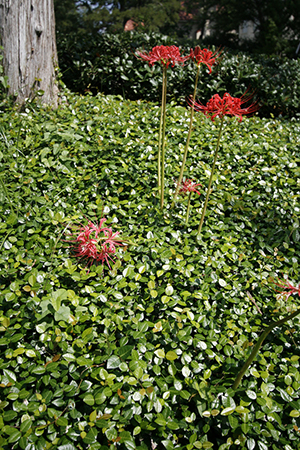Asiatic Jasmine

Asiatic jasmine is an evergreen, vine-like woody plant that is commonly used in Florida landscapes due to its hardiness and drought tolerance. Native to Japan and Korea, Trachelospermum asiaticum is a low maintenance groundcover that is great for mass plantings and turfgrass alternatives. It’s an ideal plant for people who want an attractive garden without all the hard work. In shady areas, it also provides needed texture and variation.
Characteristics
Despite the name, this plant is not related to the common jasmine plant. This climbing groundcover has small, dark green, leathery leaves with brownish-red vines. The vines slowly extend across the ground and create a dense, tangled blanket. The leaves grow in opposite pairs and are between 1-2 inches in length.
The plant will grow to at least 3 feet wide and between 6 and 18 inches tall. Asiatic jasmine has small pinwheel-shaped yellow flowers, but rarely blooms in Florida.
Once established, Asiatic jasmine requires very little maintenance to keep it looking nice. Most people use this groundcover where turfgrass won’t grow, as Asiatic jasmine will tolerate many growing conditions and suppresses weed growth.
Asiatic jasmine requires little mowing, but edges should be trimmed occasionally. It should be used in low traffic areas, as it doesn’t withstand foot traffic well. This plant is easier to control when neglected. Too much water, sun, or fertilizer can make it aggressive and unruly.
Asiatic jasmine is salt tolerant and can be grown in coastal areas. This versatile plant can even be grown in containers and hanging baskets.
Planting and Care

Asiatic jasmine requires little upkeep and will keep its beauty throughout the year. These plants are usually purchased as transplants and should be started on clear, weed-free soil.
Plants should be placed one and a half feet apart and will take two growing seasons to fill in completely. This plant will tolerate many soils, but prefers well-draining, moist soil when first planted. Once established it is drought tolerant and extremely hardy.
The plant needs little watering; with regular rainfall, extra irrigation is rarely needed. A slow-feeding fertilizer should only be applied three to four times a year for the first year, after that fertilizer should only be applied once a year in the spring when the plant is actively growing.
Asiatic jasmine should be mowed and pruned once a year in the spring to keep an attractive appearance and reduce the risk for diseases; it will also keep it controlled.
Asiatic jasmine can be grown in all areas of Florida, as it can handle cold temperatures as well as very hot ones. This plant will grow well in both dense shade and full sun, and has very few pest, disease and weed problems.
For more information on Asiatic jasmine, contact your county Extension office.
